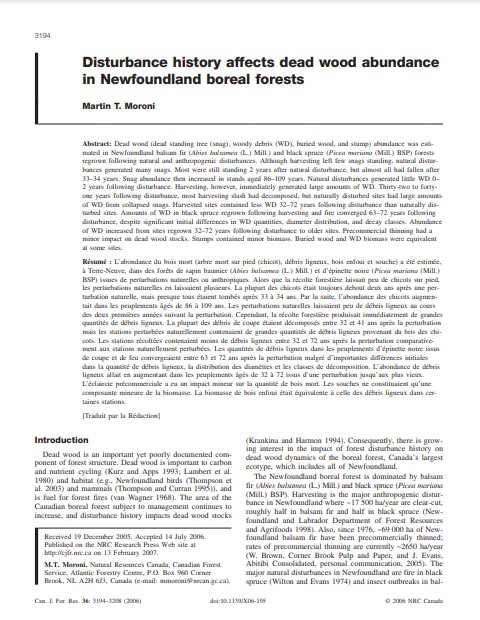Disturbance history affects dead wood abundance in newfoundland boreal forests
Bosque Modelo:
Western Newfoundland
Temática:
Cambio climático
Tipo de documento:
Artículo científico
Resumen
Dead wood (dead standing tree (snag), woody debris (WD), buried wood, and stump) abundance was estimated in Newfoundland balsam fir (Abies balsamea (L.) Mill.) and black spruce (Picea mariana (Mill.) BSP) forests regrown following natural and anthropogenic disturbances. Although harvesting left few snags standing, natural disturbances generated many snags. Most were still standing 2 years after natural disturbance, but almost all had fallen after 33–34 years. Snag abundance then increased in stands aged 86–109 years. Natural disturbances generated little WD 0–2 years following disturbance. Harvesting, however, immediately generated large amounts of WD. Thirty-two to fortyone years following disturbance, most harvesting slash had decomposed, but naturally disturbed sites had large amounts of WD from collapsed snags. Harvested sites contained less WD 32–72 years following disturbance than naturally disturbed sites. Amounts of WD in black spruce regrown following harvesting and fire converged 63–72 years following disturbance, despite significant initial differences in WD quantities, diameter distribution, and decay classes. Abundance of WD increased from sites regrown 32–72 years following disturbance to older sites. Precommercial thinning had a minor impact on dead wood stocks. Stumps contained minor biomass. Buried wood and WD biomass were equivalent at some sites.
Información Bibliográfica
Autor:
Moroni, MT.
Revista:
Canadian Journal of Forest Research
Año:
2006
N°:
12
País :
Canadá
Páginas:
3194 - 3208
Volumen:
36
Idioma:
Ingles
Palabras claves
Model forest, Adaptatation, Canada





